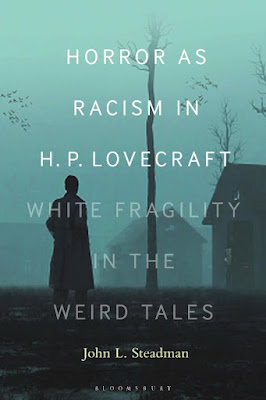Greetings Everyone!
My new book, Horror as Racism in H. P. Lovecraft: White
Fragility in the Weird Tales, has recently been released by Bloomsbury, the
foremost academic publisher in the United States and in the United Kingdom!
I hope that all of you will pick up a copy; you can order it
online from the publishers and, of course, from Amazon and other online
booksellers around the world. The book
is also available in bookstores here in the states and overseas.
https://www.bloomsbury.com/us/horror-as-racism-in-h-p-lovecraft-9798765107706/
H. P. Lovecraft, in his hybrid, degenerative monster tales,
makes use of the miscegenation
narrative, which holds that sexual liaisons or intimate, non-sexual
associations between members of different races, or species, pose a threat for
Anglo Saxon whites.
In Lovecraft’s view, miscegenation always debases the white
partner — male or female — and it can lead to the production of mixed race
children, which are, in effect, not only an abomination against natural law,
but also a threat to the longevity of the white race and to the survival of
western civilization in general.
As a further elaboration of the miscegenation narrative,
there are two types of miscegenation narratives in Lovecraft’s fiction. First, there is miscegenation by blood; in
these cases, the relationship between the two parties is always sexual, and
hybrids are produced. Second, there is
miscegenation by association; in these cases, no sexual contact occurs; the
danger, thus, arises merely from the contact between the partners.
Check out my book for analysis of how Lovecraft uses his
miscegenation narrative in some of his
most popular tales: “Herbert West—Reanimator,” “The Lurking Fear,” “The Rats in
the Walls” and one of his greatest
tales: “The Shadow Over Innsmouth”!
JLS






























